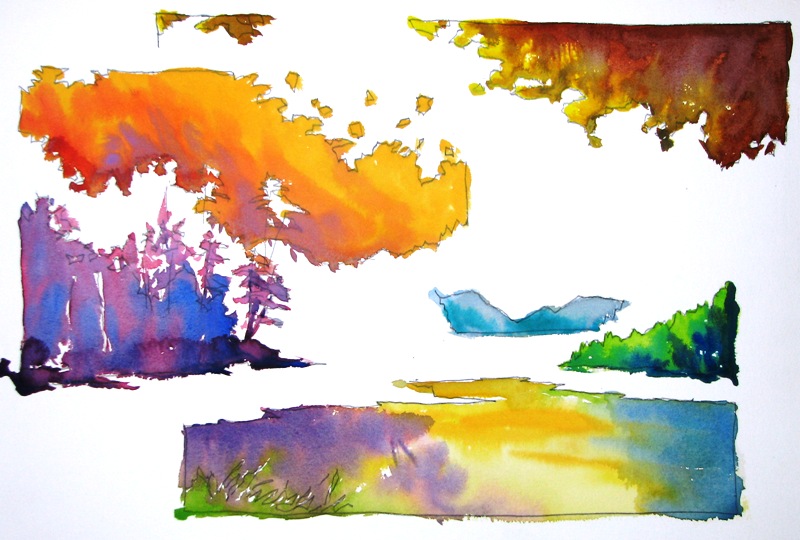Interested in an Original Painting?
Contact Virgil to inquire.
Interested in fine art prints and
more? Shop Fine Art America

"Approaching the Four-Way Stop", Watercolor, 30” X 11”
![]() 19 April 2025
19 April 2025
Early painters unerringly strive to paint objects as accurately as the eye sees them. However, It’s absolutely fundamental for budding watercolor artists to shift their focus from painting recognizable objects to perceiving and rendering the world as a collection of major shapes. This seemingly simple change in perspective unlocks a world of improvement in their painting, leading to more dynamic, engaging and expressive watercolors.


When we begin to paint, our ingrained habit is to identify and label what we see: “That’s a tree,” “That’s a house,” “That’s a person.” This intellectual labeling can actually hinder our artistic vision. Instead of truly seeing the interplay of light and shadow, the contours and volumes, we get caught up in trying to reproduce what our eyes see—leading us to attempt to paint a replica of what we see. The result, however, can often be stiff, flat, and lacking in the nuanced beauty that watercolor excels at capturing.
Thinking of our painting in terms of shapes, however, encourages us to see the painting opportunity before us. We start to notice the abstract forms created by light and shadow, the negative spaces surrounding objects, and the way different planes intersect and overlap. This approach allows us to translate the three-dimensional world onto a two-dimensional surface in a more compelling way. And it enables us to tell a story with emotion and imagination, regardless of what our eyes may actually see!

Why is this shift so important for watercolor?
• Capturing Light and Shadow: Watercolor is inherently a medium that thrives on the interplay of light and shadow. By focusing on shapes, particularly the shapes of light and shadow falling across a subject, we can create a sense of volume, depth, and atmosphere. The subtle gradations and soft edges characteristic of watercolor are perfectly suited to depicting these transitions in shape.
• Simplifying Complexity: The world is full of intricate details. Trying to paint every leaf on a tree or every brick in a wall can be overwhelming and often leads to a cluttered and overworked painting. Seeing in shapes allows us to simplify this complexity, focusing on the essential forms and their relationships. This simplification doesn’t mean losing detail; rather, it means prioritizing the most impactful visual information.
• Improving Composition: Thinking about the shapes within a scene naturally leads to a stronger understanding of composition. We begin to see how different shapes interact with each other, creating lines of movement, focal points, and overall visual harmony. This abstract approach to composition is crucial for creating engaging and well-balanced paintings.
• Fostering Expressiveness: When we are not bound by the need to create a perfect replica of an object, we have more freedom to explore the expressive qualities of watercolor. The fluid nature of the medium, its transparency, and its tendency to blend and bleed beautifully can be harnessed to create evocative shapes that convey mood and feeling.
Hints on How to See and Paint in Shapes:
1. Squint Your Eyes: This is perhaps the most effective technique. Squinting reduces the amount of detail you see, blurring the edges of objects and emphasizing the larger, simpler shapes in view, and the light and shadow. Practice identifying the dominant light and shadow shapes on your subject.
2. Trace Outlines (Mentally or Physically): Imagine or lightly sketch the basic outlines of the major shapes you see, ignoring the internal details. Think of your subject as a collection of interlocking puzzle pieces.
3. Simplify Your Palette: Using a limited palette can help you focus on value (lightness and darkness) and shape rather than getting bogged down in color mixing.
4. Practice Regularly: Like any skill, seeing and painting in shapes takes practice. Make a conscious effort to observe the world around you in this way, even when you’re not painting. The more you train your eye, the more natural this way of seeing will become.


By consciously shifting your focus from identifying objects to observing and painting the major shapes, you’ll unlock a more profound understanding of light, form, and composition in watercolor. Instead of attempting to paint a replica of what you see, this fundamental shift will lead to more dynamic, nuanced, and ultimately more satisfying paintings. Embrace the abstract beauty of the shapes you see, and let your watercolor brush bring them to life, telling your story with imagination and feeling.
Contact Virgil to inquire.
more? Shop Fine Art America

“You Must Go Left or Right” , Watercolor, 30” X 11”